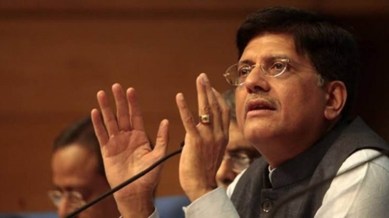Stay updated with the latest - Click here to follow us on Instagram
At meet with Piyush Goyal, states bat for agri export boost: Lift curbs, allocate infra funds
The state ministers were speaking to Goyal at the annual Board of Trade (BoT) meeting in Mumbai where they also sought a stable trade regime on agricultural products.

Hours before the Union government lifted the minimum export price (MEP) for onions and Basmati rice, a majority of states Friday asked Union Commerce Minister Piyush Goyal to lift export restrictions on various agricultural items, including onions, to boost farm incomes.
The state ministers were speaking to Goyal at the annual Board of Trade (BoT) meeting in Mumbai where they also sought a stable trade regime on agricultural products.
monthly limit of free stories.
with an Express account.
Most of the ministers are learnt to have asked the Centre to lift restrictions on wheat, broken rice, non-basmati white rice, sugar, and onions, which, they said, would help boost farmers’ income.
On Friday, the government lifted the MEP for onions and Basmati rice. It also reduced the onion export duty. These decisions come ahead of Assembly elections in Haryana and Maharashtra.
“A number of states called for a stable trade policy on food exports in the interest of farmers. However, the Commerce Minister reiterated the government’s aim to ensure food availability for domestic requirements before allowing exports,” a source said.
The export of a number of food items was restricted to curb food inflation, which had remained at elevated levels due to supply chain disruptions following the pandemic, heatwaves, and the Russia-Ukraine war that began in February 2022. Retail food inflation stood at 5.66 per cent in August.
Agricultural economists have argued that export bans could be protecting the middle class from inflation at the expense of farmers, as about 800 million people already receive free wheat or rice (5 kg per person per month) under the public distribution system.
At the meeting, the state ministers also sought the allocation of funds for the development of infrastructure needed to boost exports under the ‘Districts as Export Hubs’ initiative.
“The states are seeking funds under the Districts as Export Hubs scheme, as strategies have been developed, various district promotion committees have been formed, and bottlenecks have been identified. However, without the availability of funds, progress will be difficult,” a source familiar with the developments said.
Under the Districts as Export Hubs initiative, products with export potential are identified from all 765 districts in the country. However, as this is not a formal scheme, no financial assistance has been provided, according to an official statement.
Meanwhile, exporters who were also present at the meeting raised concerns over the flow of credit, container shortages, missed shipping schedules and logistical challenges stemming from the Red Sea crisis. The exporters said freight rates had surged to record levels, affecting business.
“Container issues, long voyage times, and some countries attracting more ships while Indian ports are bypassed were discussed. Solutions, such as concessions on tonnage tax and GST rates, were also explored. In addition, access to credit was raised. We have seen a decline in export credit between March 2022 and March 2024, despite the need for more credit for longer durations due to the rise in commodity prices amid soaring freight rates,” said FIEO Director General Ajay Sahai.
Sudhir Sekhri, of the Apparel Export Promotion Council (AEPC), sought the liberalisation of raw material imports. “The Indian apparel industry needs high-quality man-made fibre (MMF) fabric. The current system is cumbersome and outdated. We need a new scheme that allows garment exporters to import duty-free fabric, with import entitlement fixed in value terms only,” he said.
Sekhri added that given the increasing importance of environmental, social, and governance (ESG) compliance in overseas markets, particularly in the EU and the US, it is essential that India prioritises the upgrading of sustainability compliance-related infrastructure.
“To promote and encourage sustainability and green manufacturing, the Indian government could establish a refinancing scheme—similar to some of our competitor countries, like Bangladesh. This scheme could provide long-term soft loans (with terms ranging from 3 to 10 years) at a maximum interest rate of 5 per cent,” Sekhri said.